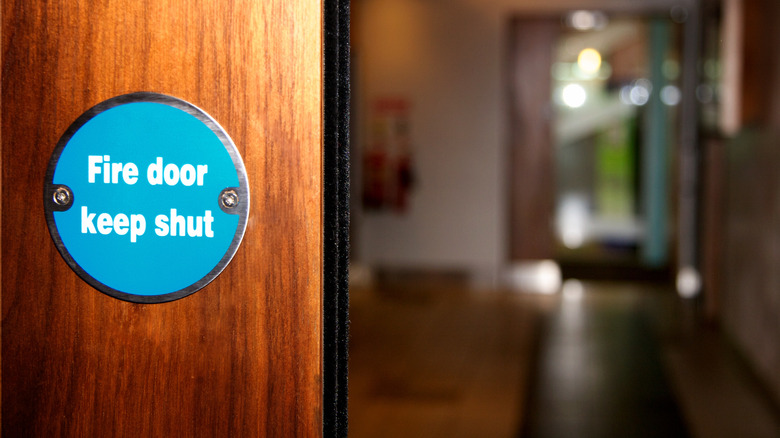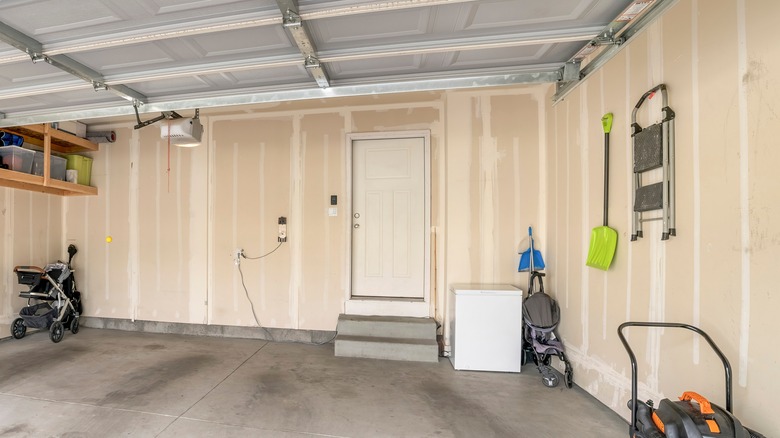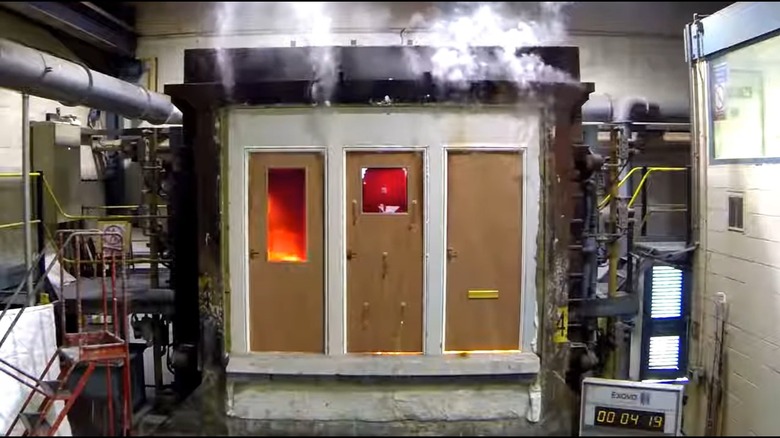What Is A Fire-Rated Door And Where Should They Go In Your Home?
At first glance, having fire-resistive or fire-protective doors in your home seems like a no-brainer. However, the discussion of fire-rated doors quickly descends into a tangle of international standards, body abbreviations, technical language, competing interpretations, differences between commercial and residential rules, and every other flicker of confusion you can imagine. So, let's simplify the topic as much as possible: fire-rated doors resist fire, heat, and smoke for a specified amount of time (their rating), and they're not necessarily required anywhere in a single-family residence.
While you can install a fire-rated door wherever you want, current building codes only require their use in a few residential situations; for owners of single-family homes, that only includes the doorway between a living space and an attached garage. Even that isn't necessarily a firm requirement because the International Residential Code says you may also use solid wood, solid steel, or honeycomb-core steel doors that are at least 1 3/8 inches thick (the standard thickness of interior doors) and have automatic closing mechanisms.
Building codes focus on the garage doorway because of its typical contents, which often include combustible materials (gas, oil, solvents) – especially oily rags, a seemingly harmless garage item that may be a fire hazard. According to the National Fire Incident Reporting System, fires that start in garages spread more, cost more, and injure more people than those in all other parts of the home.
What is a fire-rated door?
It would probably help to understand what all this talk about fire-rated doors means. First, it doesn't mean the door itself but the "door assembly," including the frame, glazing, and mechanisms (think locks and hinges). Residential fire-rated doors are tested and assigned a rating of 20, 45, 60, and 90 minutes. A 180-minute rating is mainly relevant to commercial fire-rated doors. This number refers to the amount of time a door assembly (the door and all that other stuff) managed to hold heat, smoke, and fire in check during testing. This protection is the same reason it's safer to go to bed with a closed door: Closed doors slow fire down. You can find this rating on a label mounted to the door and frame on the hinge side.
A fire-rated door can be made of wood, steel, or fiberglass. Whatever its composition, a door with a rating above 20 minutes must withstand the stream of a fire hose at a distance of 20 feet. The ability of the assembly to cope with rapidly rising temperatures is another factor, and coded ratings for fire-rated doors will indicate which of these various tests have been passed. Incidentally, there might be one other fire-rated door in your home: before you install one, you should know that laundry chute doors should also be fire-rated.
Choosing a fire-rated door
Because of the rigorous testing and various fire rating regulations, these door assemblies can be complicated and a little pricey. Practically speaking, most residential fire-rated door assemblies will be made of steel or fiberglass. Because of code requirements, they will have locksets that allow egress, and they should close on their own because of hinge design or other mechanisms. Technically, a fire-rated door can't include hardware that will hold it open (unless a fire alarm system controls it).
Selection of these doors can be relatively limited without a bit of effort. Lowe's sells 38 fire-rated doors, ranging from a $344.00 20-minute-rated door to a $428.00 20-minute-rated door. None of the stocked doors include glass. All are, somewhat mysteriously, referred to as front doors. Home Depot had no residential doors rated above 20 minutes at any of the five local locations we checked. Menard's offers one 90-minute-rated door ($462.00) and four 20-minute fire-rated doors in various styles. You can also find doors rated beyond the usual 20 minutes from door vendors online, like this 60-minute door from ETO Doors ($799-899), but tracking them down can be difficult, and your best course might be to check with a local door and window retailer.


